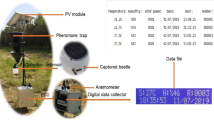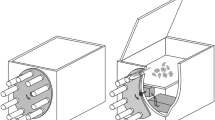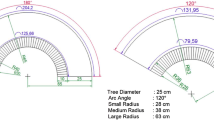Abstract
Forests, a valuable source provided by nature to living beings, are indispensable for many living organisms; hence, it is important to ensure the sustainability of forests. Determining the factors that exposure threats to the forests, executing protective methods against them and putting these methods into practise are important for the ecological cycle. Bark beetles, which have destructive effects on the ecosystem, are one of the factors that expose a threat to forests. Therefore, monitoring of these species and determination of effective control strategies are increasingly gaining importance in forestry. Conventional pheromone traps, which are being currently used, provide limited information on flight times of target species. Therefore, the technological development of the capture systems of these traps will determine future control trends. Hence, pheromone traps with electronic control unit were prepared in earlier (ѵ1) and new designed (ѵ2) versions. In ѵ2, 97.5% of target species were counted, and instant temperature, humidity and time parameters at the time of capture were recorded at a practiced field work for the system. In addition to the instant parameters recorded in ѵ2, an anemometer used for measuring wind speed, which is considered to have influence on the behaviour of target species, was incorporated into the system. In the trials, the counting success rates under daylight and darkness conditions for Ips sexdentatus adults were 98.1 and 97%, whereas the counting success rates for Pityocteines curvidens adults, which are smaller in size, were 96 and 99%, respectively. In conclusion, data obtained by recording the amount of target species along with the capture moment and parameters related to this will be very useful and provide determinative in the management of target species.





Similar content being viewed by others
References
Baker, T. C. (2008). Use of pheromones in IPM. In T. Radcliffe & B. Hutchinson (Eds.), Integrated pest management (pp. 273–285). Cambridge: Cambridge University Press.
Bakke, A. (1991). Using pheromones in the management of bark beetle outbreaks. In Baranchikov, Y.N., Mattson, W.J., Hain, F.P. and Payne, T. L. (Eds.), Forest insect guilds: patterns of interaction with host trees (pp. 371–377). Gen. Tech. Rep. NE-153. Forest Service, U.S. Department of Agriculture.
Byers, J. A. (1996). An encounter rate model of bark beetle population searching at random for susceptible host trees. Ecological Modelling, 91, 57–66.
Byers, J. B. (2006). Mountain pine beetle population sampling: inferences from Lingred pheromones trap and tree emergence cages. Canadian Journal of Forest Research, 36, 351–360.
Faccoli, M., & Stergulc, F. (2004). Ips typographus (L.) pheromone trapping in South Alps: spring catches determine damage thresholds. Journal of Applied Entomology, 128, 307–311. https://doi.org/10.1111/j.1439-0418.2004.00848.307.
Faccoli, M., & Stergulc, F. (2006). A practical method for predicting the short-time trend of bivoltine populations of Ips typographus (L.) (Coleoptera, Scolytidae). Journal of Applied Entomology, 130(1), 61–66.
Faccoli, M., & Stergulc, F. (2008). Damage reduction and performance of mass trapping devices for forest protection against the spruce bark beetle, Ips typographus (Coleoptera Curculionidae Scolytinae). Annals of Forest Science, 65(3), 309.
Galko, J., Økland, B., Nikolov, C., Rell, S., & Kunca, A. (2013). Comparison of pheromone traps for monitoring of the European spruce bark beetle. Oppdragsrapport Skog og landskap.
Galko, J., Nikolov, C., Kunca, A., Vakula, J., Gubka, A., Zúbrik, M., Rell, S., & Konôpka, B. (2016). Effectiveness of pheromone traps for the European spruce bark beetle: a comparative study of four commercial products and two new models. Lesnícky časopis-Forestry Journal, 62, 207–215.
Gillette, N.E.; & Munson, S. (2007). Semiochemical sabotage: behavioral chemicals for protection of Western conifers from bark beetles. In J.L. Hayes and J.E. Lundquist (compilers) (Eds.), The Western bark beetle research group: a unique collaboration with forest health protection proceedings of a symposium. Society of American Foresters Conference October 23–28, Portland, Oregon, pp. 85–109.
Gitau, C. W., Bashford, R., Carnegie, A. J., & Gurr, G. M. (2013). A review of semiochemicals associated with bark beetle (Coleoptera: Curculionidae: Scolytinae) pests of coniferous trees: A focus on beetle interactions with other pests and their associates. Forest Ecology and Management, 297, 1–14.
Gómez, D., Hirigoyen, A., Balmelli, G., Viera, C., & Martínez, G. (2017). Patterns in flight phenologies of bark beetles (Coleoptera: Scolytinae) in commercial pine tree plantations in Uruguay. BOSQUE, 38(1), 47–53.
Hansen, E. M. (2014). Forest development and carbon dynamics after mountain pine beetle outbreaks. Forest Science, 60, 476–488.
Hayes, C. J., DeGomez, T. E., Clancy, K. M., Williams, K. K., McMillin, J. D., & Anhold, J. A. (2008). Evaluation of funnel traps for characterizing the bark beetle (Coleoptera: Scolytidae) communities in ponderosa pine forests of north-central Arizona. Journal of Economic Entomology, 101(4), 1253–1265.
Holuša, J., Lukášová, K., & Lubojacký, J. (2012). Comparison of seasonal flight activity of Ips typographus and Ips duplicatus. Scientia Agriculturae Bohemica, 43(3), 109–115.
Kautz, M., Imron, M. I., Dworschak, K., & Schopf, R. (2016). Dispersal variability and associated population-level consequences in tree-killing bark beetles. Movement Ecology, 4(9). https://doi.org/10.1186/s40462-016-0074-9.
Knodel, J., Petzoldt, C. H., & Hoffman, M. P. (1995). Pheromone traps–effective tools form Lepidopterous insect pests of sweet corn. Vegetables.
Krieger, C. (1998). An overview of bark beetle control methodologies. Management Notes, 17.
Lindelow, A., & Schroeder, M. (2001). Spruce bark beetle, Ips typographus (L.), in Sweden: monitoring and risk assessment. Journal of Forest Science, 47, 40–42.
Lindgren, B. S., & Borden, J. H. (1983). Survey and mass trapping of ambrosia beetles (Coloptera: Scolytidae) in timber processing areas on Vancouver Island. Canadian Journal of Forest Research, 13, 481–493.
Lindgren, B. S., & Raffa, K. F. (2013). Evolution of tree killing in bark beetles (Coleoptera: Curculionidae): Trade-offs between the maddening crowds and a sticky situation. Canadian Journal of Forest Research, 145, 471–495.
Macek, M., Wild, J., Martin Kopecký, M., Svoboda, M., & Fischer, A. (2017). Life and death of spruce forest: ecological processes in the first 12 years after bark-beetle outbreak. In: 2nd International Conference on Forests, 26–29 April, Germany. 38 p.
Marini, L., Økland, B., Jönsson, A. M., Bentz, B., Carroll, A., Forster, B., Grégoire, J. C., Hurling, R., Nageleisen, L. M., Netherer, S., Ravn, H. P., Weed, A., & Schroeder, M. (2017). Climate drivers of bark beetle outbreak dynamics in Norway spruce forests. Ecography, 40, 001–010. https://doi.org/10.1111/ecog.02769.
Meddens, A. J. H., Hicke, J. A., & Ferguson, C. A. (2012). Spatiotemporal patterns of observed bark beetle-caused tree mortality in British Columbia and the western United States. Ecological Applications, 22(7), 1876–1891.
Meurisse, N., & Pawson, S. (2017). Quantifying dispersal of a non-aggressive saprophytic bark beetle. PLoS One, 12(4), e0174111. https://doi.org/10.1371/journal.Pone.0174111.
Meurisse, N., Couillien, D., & Grégoire, J. C. (2008). Kairomone traps: a tool for monitoring the invasive spruce bark beetle Dendroctonus micans (Coleoptera, Scolytinae) and its specific predator, Rhizophagus grandis (Coleoptera, Monotomidae). Journal of Applied Ecology, 45, 537–548.
Nansen, C. (2004). Technology calculating pheromone trap catches. Pest Control, 36–38.
Negrón, J. F., & Popp, J. B. (2017). Can spruce beetle (Dendroctonus rufipennis Kirky) pheromone trap catches or stand conditions predict Engelmann spruce (Picea engelmannii Parry ex Engelm.) tree mortality in Colorado? Agricultural and Forest Entomology. https://doi.org/10.1111/afe.12239.
Özcan, G. E. (2017). Assessment of Ips sexdentatus population considering the capture in pheromone traps and their damages under non-epidemıc conditions. Journal of the Forestry Society of Croatia, 1–2, 47–56.
Özcan, G. E., Eroğlu, M., & Alkan-Akıncı, H. (2011). Use of pheromone-baited traps for monitoring Ips sexdentatus (Boerner) (Coleoptera: Curculionidae) in oriental spruce stands. African Journal of Biotechnology, 10(72), 16351–16360.
Özcan, G. E., Cicek, O., Enez, K., & Yıldız, M. (2014). A new approach to determine the capture conditions of bark beetles in pheromone-baited traps. Biotechnology & Biotechnological Equipment, 28(6), 1057–1064.
Özcan, G. E., Çiçek, O., Enez, K., & Yıldız, M. (2016). Evaluation of the counting success of pheromone-baited trap with electronic control unit in practice. Current Science, 111(1), 192–197. https://doi.org/10.18520/cs/v111/il/192-197.
Panzavolta, T., Bracalini, M., Bonuomo, L., Croci, F., & Tiber, R. (2014). Field response of non-target beetles to Ips sexdentatus aggregation pheromone and pine volatiles. Journal of Applied Entomology, 138, 586–599.
Raffa, K. F., Phillips, T. W., & Salom, S. M. (1993). Strategies and mechanisms of host colonization by bark beetles. In T. D. Schowalter & G. M. Filip (Eds.), Beetle-pathogen interactions in conifer forests (pp. 103–120). New York: Academic Press.
Raty, L., Drumont, A., De Windt, N., & Grégoire, J. -C. (1995). Mass trapping of the spruce bark beetle Ips typographus L. traps or trap trees? Forest Ecology and Management, 78, 191–205.
Rudinsky, J. A. (1962). Ecology of scolytidae. Annual Review of Entomology, 7, 327–348.
Sagitov, A., Mukhamadiev, N., Ashikbaev, N., Mazarzhanova, K., Bolat, Z., Mendibaeva, G., & Abzhanbayev, D. (2016). Pheromone traps application against bark beetles (Coleoptera: Scolytidae) in Ili-Alatau Mountains. Kastamonu University Journal of Engineering and Sciences, 2(1), 14–20.
Sánchez-Martínez, G., & Wagner, M. R. (2002). Bark beetle community structure under four ponderosa pine forest stand conditions in northern Arizona. Forest Ecology and Management, 170, 145–160.
Schowalter, T. D. (2012). Ecology and management of bark beetles (Coleoptera: Curculionidae: Scolytinae) in southern pine forests. Journal of Integrated Pest Management, 3(2), A1–A7. https://doi.org/10.1603/IPM11025.
Schwab, O., Maness, T., Bull, G., & Roberts, D. (2009). Modeling the effect of changing market conditions on mountain pine beetle salvage harvesting and structural changes in the British Columbia forest products industry. Canadian Journal of Forest Research, 39, 1806–1820.
Turchin, P., & Odendall, F. J. (1996). Measuring the effective sampling area of a pheromone trap for monitoring population density of southern pine beetle. (Coleoptera: Scolytidae). Environmental Entomology, 25(3), 582–588.
Wainhouse, D. (2005). Ecological methods in forest pest management. New York: Oxford University Press.
Weslien, J., Annila, E., Bakke, A., Bejer, B., Eidman, H. H., Narvestad, K., Nikula, A., & Ravn, H. P. (1989). Estimating risks for spruce bark beetle (Ips typographus (L.)) damage using pheromone-baited traps and trees. Scandinavian Journal of Forest Research, 4, 87–98.
Wood, S. L., & Bright, D. E. (1992). A catalog of scolytidae and platypodidae (Coleoptera). Part 2. Taxonomic index. Great Basin Naturalist Memoirs, 13, 1–1553.
Yonker, C. R. (1990). Pheromone trapping applications for monitoring European elm bark beetle populations. Journal of Arboriculture, 16(6), 148–152.
Zang, C., Helm, R., Sparks, T. H., & Menzel, A. (2015). Forecasting bark beetle early flight activity with plant phenology. Climate Research, 66, 161–170.
Zúbrik, M., Raši, R., Vakula, J., Varínsky, J., Nikolov, C., & Novotný, J. (2008). Bark beetle (Ips typographus L., Pityogenes chalcographus L., Col.: Scolytidae) pheromone traps spatial distribution optimisation in central Slovakian mountains. Forestry Journal, 54(3), 235–248.
Author information
Authors and Affiliations
Corresponding author
Rights and permissions
About this article
Cite this article
Özcan, G.E., Çіçek, O., Enez, K. et al. A new design of electronic control unit involving microcontroller to determine important parameters for target species in forest. Environ Monit Assess 190, 600 (2018). https://doi.org/10.1007/s10661-018-6960-4
Received:
Accepted:
Published:
DOI: https://doi.org/10.1007/s10661-018-6960-4




